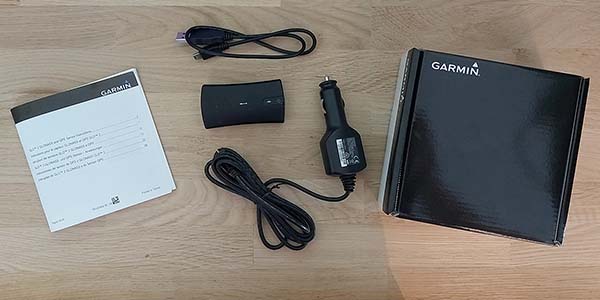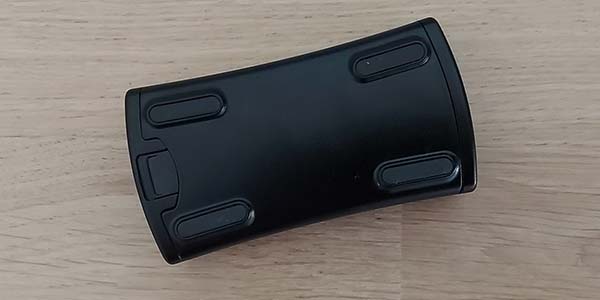Garmin GLO 2: Reviewed By A Professional Navigator
As an Amazon Associate, Casual Navigation earns from qualifying purchases.
I recently wanted to test a whole selection of maritime navigation apps on my iPad.
Unfortunately, it quickly became apparent that my WiFi-only iPad did not have an integrated GPS.
My solution was to buy a Garmin GLO 2 GPS & GLONASS Bluetooth Receiver.
The Garmin GLO 2 is an affordable Bluetooth GPS / GLONASS receiver for providing location data to a device that does not already have an integrated GPS. I found it simple to use, and once it is set up all you need to do is turn it on and you are good to go.
| Positives | Negatives |
|---|---|
| Plug and play | USB Mini connection |
| Small size | Minimal battery level feedback |
| Steady connection | Pushes apps |
At around 8cm in length, the GLO 2 is a compact and robust feeling GNSS receiver for both GPS and GLONASS satellites.
Connecting it to my iPad and Android phone was as simple as connecting to any other Bluetooth device. You literally turn it on and pair it with the device you want to use.
Annoyingly, when you pair for the first time, you are prompted to download apps to be able to use the GLO 2. I did not download any of them and could use the GLO 2 just fine with other navigational apps.
Once paired, each time you want to use the GLO 2, you simply turn it on and leave it with a view of the sky.
I found it acquired satellites quickly and reliably every time. It had always connected and was providing data by the time I started up the navigation apps that I wanted to use.
During use, it stayed locked onto satellites no matter where I placed it on my boat. Most of the time, I left it protected in the companionway and had no issues at all.
The battery always lasted the entire day while in use, and was easily charged by the portable power bank I took with me.
My only criticism in this respect is that it takes a USB-Mini cable when all my other electronic devices are USB-C. I needed to take an extra cable just for the GLO 2.
Overall though, I am very happy with my GLO 2 and will be continuing to use it for a GPS feed when using my iPad on my boat.
What Is In The Box?

The Garmin GLO 2 comes securely packaged in a relatively large box considering the compact size of the receiver.
Within the box, you have the following:
Gamin GLO 2 GPS GLONASS Bluetooth Receiver
The receiver itself is small and lightweight. It is made up of the main plastic body, the battery, and the battery cover.
On the body, you have a power button and two LEDs for the “Bluetooth” and “Status” indications.
Mine shipped with the battery in a separate bag, but you may find the batter already installed on your unit.
The GLO 2 is smaller than I imagined, measuring approximately 8cm x 4cm x 2cm.
USB charging cable
The USB charging cable has a regular USB Type A on one end, and a USB Type Mini-A on the other end.
The USB Mini end plugs into the Garmin GLO 2, and the USB end plugs into any of your existing chargers.
At home, I connected the USB cable to my phone charger to use mains power. On my boat, I connected the USB charging cable to a battery pack to use portable power.
Automobile auxiliary outlet (cigarette lighter) charging cable
The auxiliary cable connects the Garmin GLO 2 to the cigarette lighter socket but otherwise works in the same way as the charging cable.
Instruction manual
The instruction manual contains instructions for the GLO 2, written in 6 different languages.
In my instructions, the English instructions take up approximately 5 ½ pages.
Build Quality
The Garmin GLO 2 is made from plastic, but it has a reassuringly premium feel to it.
On the bottom are four rubber soles so that you can place it down on a smooth surface and it should not slide around.

The battery cover feels secure and has a double-action slider to lock it in place so that you cannot accidentally knock it open.
The device itself has 2 lights, indicating the satellite connection status and the Bluetooth connection status.
Its indicators are not labelled, but the colour coding is well thought out because the blue light tells you the Bluetooth status.
The only weakness in its premium feel is the power button. It is a little hard to press and does not provide a reassuring stop or click when it has been depressed enough.
I often found myself pressing the power button for longer than necessary because there is minimal feedback.
Fortunately, there is no difference between a “press” and a “long press”. The power button simply turns the device on and off.
Connecting to the Garmin GLO 2 using Bluetooth
The GLO 2 is designed specifically for the iPod, iPad and iPhone, but you can use it with most Bluetooth enabled mobile devices.
I successfully connected it to my iPad Mini, as well as my Android phone.
In both cases, all you do is turn on the GLO 2, and use pairing mode in the device you want to connect to.
For example, to connect to my phone I turned on the GLO 2, then turned on my phone’s Bluetooth and searched for nearby devices.
When the GLO 2 appeared in the list, I just pressed “Connect” and it worked.
The GLO 2 tells you when it is connected using its Bluetooth connection light, conveniently coloured blue to help you remember.
| LED | Description |
|---|---|
| Slow flashing blue | Searching |
| Quick flashing blue | Pairing |
| Solid blue | Connected |
Connecting the Garmin GLO 2 to satellites
To get positional data from the GLO 2, it needs to connect to satellites. The beauty of the GLO 2 is that it can either connect to GPS satellites or GLONASS satellites.
GPS is the most common satellite system run by the USA, and GLONASS is an equivalent system run by Russia.
To connect to satellites, all you do is switch on the GLO 2, and leave it where it will have an unobstructed line of sight to the sky.
I found that with a clear view of the sky, the GLO 2 was quick to connect, and I never lost signal the whole time I used it.
I always turned the GLO 2 on when I switched on my iPad. By the time I had started up my navigational apps, the GLO 2 was already connected to satellites and providing data.
The GLO 2 provides feedback on its satellite connection status through its Status LED.
| LED | Description |
|---|---|
| Slow flashing orange | Charging |
| Solid orange | Battery charged Power connected |
| Rapid flashing orange | Low battery |
| Alternating orange & green | Error |
| Flashing green | Searching for satellites |
| Solid green | Satellite fix |
The Garmin GLO 2 app
When I first connected the GLO 2 to my iPad, it told me that I needed to download an app to be able to use it.
The suggestions were all Garmin apps that I assume use the GLO 2 to provide a GPS feed.
I did not want any as I was hoping to use my own navigational apps instead.
The messages were a little concerning and made me think that I needed to have one for the GLO 2 to work. This was not the case!
In the end, I did not download anything and I found that the GLO 2 worked just fine without a specific app.
Usability
I found that the Garmin GLO 2 was incredibly easy to use, except when I first connected it and it asked me to download the app.
Once I had ascertained that the extra app was not necessary, however, the GLO 2 performed well.
Throughout my three day passage, the GLO 2 remained connected to satellites no matter where I placed it on my boat.
A lot of the time I left it just inside the companionway so that it could still see the sky, but it was protected from the wind and the weather.
The small rubberised feet kept it secure and meant it didn’t side around, even on my small boat.
The GLO 2’s size was unobtrusive and would easily fit in the bag that also carried my iPad.
USB charging meant that I could use the power bank that I carried with me.
The only improvement that could be made for charging would be for it to charge via a Type C port instead.
The Garmin GLO 2 was the only device I carried that needed a USB-Mini cable, so I had to carry an extra cable just for that.

Battery
Garmin claims that the GLO 2 has an expected life of 13hrs.
I found that the battery life was excellent, but I never tested it to its extreme limits.
As I carried a portable power bank, I charged the GLO 2 overnight when I anchored.
In my case, I turned it on around 0700 when I left the anchorage in the morning, and it was still working at 1700 when I anchored for the next evening.
There is no percentage reading to tell how well charged it is, so you would need to just note the “low battery” warning when it starts flashing.
Unfortunately, there is no information about how long you have when the “low battery” light starts flashing.
Interestingly though, the instructions do state that you can continue to use the GLO 2 when it is charging. Had it gone flat, I could have charged it while continuing to sail using my portable power bank.
My Verdict
Overall, I am very happy with the Garmin GLO 2, and I will be continuing to use it to provide GPS data to my iPad when I am sailing.
The device is small and feels robust enough to survive plenty of trips on my boat, and the battery lasts long enough to do a full day’s sailing on one charge.
Now that I have paired it with my phone and my iPad, all I need to do is turn on each device and they pair themselves automatically and just work.
Aside from charging it, the GLO 2 need no input from me. I can literally just turn it on and it gets itself ready for use.
I would happily recommend the GLO 2 for anyone needing to provide a GPS feed to an iPad that does not already have an integrated GPS.
Garmin GLO 2 Frequently Asked Questions
How accurate is the Garmin GLO 2?
According to Garmin’s website, the accuracy of the GLO 2 is 3m, with an update rate of 10x per second (depending on the device you connect it to).
Information from Garmin’s Website: https://buy.garmin.com/en-US/US/p/645104#specs
What is the Garmin GLO 2 used for?
The Garmin GLO 2 is used to provide a GPS signal to a Bluetooth enabled device that is unable to receive a GPS signal.
One common use is for a WiFi-only iPad, which does not have its own integrated GPS.
Another use is when you want to use your iPad inside, but you still want a clear GPS signal, for example on an aircraft or in a boat.
